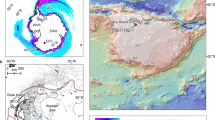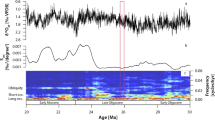Abstract
Knowledge of the past variability of climate at high northern latitudes during astronomical analogues of the present interglacial1 may help to inform our understanding of future climate change. Unfortunately, long-term continuous records of ice-sheet variability in the Northern Hemisphere only are scarce because records of benthic 18O content represent an integrated signal of changes in ice volume in both polar regions2. However, variations in Northern Hemisphere ice sheets influence the Siberian High3 (an atmospheric pressure system), so variations in the East Asian winter monsoon (EAWM)—as recorded in the aeolian dust deposits on the Chinese Loess Plateau—can serve as a useful proxy of Arctic climate variability before the ice-core record begins. Here we present an EAWM proxy record using grain-size variations in two parallel loess sections representative of sequences across the whole of the Chinese Loess Plateau over the past 900,000 years. The results show that during periods of low eccentricity and precessional variability at approximately 400,000-year intervals, the grain-size-inferred intensity of the EAWM remains weak for up to 20,000 years after the end of the interglacial episode of high summer monsoon activity and strong pedogenesis. In contrast, there is a rapid increase in the EAWM after the end of most other interglacials. We conclude that, for both the 400,000-year interglacials, the weak EAWM winds maintain a mild, non-glacial climate at high northern latitudes for much longer than expected from the conventional loess and marine oxygen isotope records. During these times, the less-severe summer insolation minima at 65° N (ref. 4) would have suppressed ice and snow accumulation, leading to a weak Siberian High and, consequently, weak EAWM winds.
This is a preview of subscription content, access via your institution
Access options
Subscribe to this journal
Receive 51 print issues and online access
$199.00 per year
only $3.90 per issue
Buy this article
- Purchase on Springer Link
- Instant access to full article PDF
Prices may be subject to local taxes which are calculated during checkout




Similar content being viewed by others
References
Loutre, M. F. & Berger, A. Marine Isotope Stage 11 as an analogue for the present interglacial. Global Planet. Change 36, 209–217 (2003)
Raymo, M. E., Lisiecki, L. E. & Nisancioglu, K. H. Plio-Pleistocene ice volume, Antarctic climate, and the global δ18O record. Science 313, 492–495 (2006)
Ding, Z., Liu, T., Yu, Z., Guo, Z. & Zhu, R. Ice-volume forcing of East Asian winter monsoon variations in the past 800,000 years. Quat. Res. 44, 149–159 (1995)
Laskar, J., Joutel, F. & Boudin, F. Orbital, precessional, and insolation quantities for the Earth from -20 Myr to +10 Myr. Astron. Astrophys. 270, 522–533 (1993)
Alley, R. B., Clark, P. U., Huybrechts, P. & Joughin, I. Ice-sheet and sea-level changes. Science 310, 456–460 (2005)
Shackleton, N. J. The 100,000-year ice-age cycle identified and found to lag temperature, carbon dioxide, and orbital eccentricity. Science 289, 1897–1902 (2000)
de Vernal, A. & Hillaire-Marcel, C. Natural variability of Greenland climate, vegetation, and ice volume during the past million years. Science 320, 1622–1625 (2008)
Berger, A. & Loutre, M. F. An exceptionally long interglacial ahead? Science 297, 1287–1288 (2002)
McManus, J. F., Oppo, D. W. & Cullen, J. L. A 0.5-million-year record of millennial-scale climate variability in the North Atlantic. Science 283, 971–975 (1999)
Lisiecki, L. & Raymo, M. A Pliocene-Pleistocene stack of 57 globally distributed benthic δ18O records. Paleoceanography 20, PA1003 (2005)
Jouzel, J. et al. Orbital and millennial Antarctic climate variability over the past 800,000 years. Science 317, 793–796 (2007)
Howard, W. R. A warm future in the past. Nature 388, 418–419 (1997)
Droxler, A. W., Alley, R. B., Howard, W. R., Poore, R. Z. & Burckle, L. H. in Earth's Climate and Orbital Eccentricity: The Marine Isotope Stage 11 Question (eds Droxler, A. W., Poore, R. Z. & Burckle, L. H. ) 1–14 (AGU Geophys. Monogr. Ser. 137, 2003)
An, Z. et al. The long-term paleomonsoon variation recorded by the loess-paleosol sequence in central China. Quat. Int. 7–8, 91–95 (1990)
Porter, S. C. & An, Z. S. Correlation between climate events in the North Atlantic and China during last glaciation. Nature 375, 305–308 (1995)
Liu, T. & Ding, Z. Chinese loess and the paleomonsoon. Annu. Rev. Earth Planet. Sci. 26, 111–145 (1998)
Panagiotopoulos, F., Shahgedanova, M., Hannachi, A. & Stephenson, D. B. Observed trends and teleconnections of the Siberian high: a recently declining center of action. J. Clim. 18, 1411–1422 (2005)
Nugteren, G. & Vandenberghe, J. Spatial climatic variability on the Central Loess Plateau (China) as recorded by grain size for the last 250 kyr. Global Planet. Change 41, 185–206 (2004)
Liu, T. Loess and the Environment (China Ocean, 1985)
Kukla, G. & An, Z. S. Loess stratigraphy in central China. Palaeogeogr. Palaeoclimatol. Palaeoecol. 72, 203–225 (1989)
Sun, Y., Clemens, S. C., An, Z. & Yu, Z. Astronomical timescale and palaeoclimatic implication of stacked 3.6-Myr monsoon records from the Chinese Loess Plateau. Quat. Sci. Rev. 25, 33–48 (2006)
Ding, Z. L. et al. Stacked 2.6-Ma grain size record from the Chinese loess based on five sections and correlation with the deep-sea δ18O record. Paleoceanography 17, 1033 (2002)
Imbrie, J. & Imbrie, J. Z. Modeling the climatic response to orbital variations. Science 207, 943–953 (1980)
Milankovitch, M. Kanon der Erdebestrahlung und seine Anwendung auf das Eiszeitenproblem (Stamparija Mihaila Curcica, 1941); Canon of Insolation and the Ice-age Problem [English transl.] (Israel Program for Scientific Translations, US Department of Commerce and the National Science Foundation, 1969)
Vettoretti, G. & Peltier, W. Sensitivity of glacial inception to orbital and greenhouse gas climate forcing. Quat. Sci. Rev. 23, 499–519 (2004)
Ruddiman, W. F. Orbital insolation, ice volume, and greenhouse gases. Quat. Sci. Rev. 22, 1597–1629 (2003)
Kutzbach, J. et al. Climate and biome simulations for the past 21,000 years. Quat. Sci. Rev. 17, 473–506 (1998)
Rohling, E. et al. Antarctic temperature and global sea level closely coupled over the past five glacial cycles. Nature Geosci. 2, 500–504 (2009)
Huybrechts, P. & de Wolde, J. The dynamic response of the Greenland and Antarctic ice sheets to multiple-century climatic warming. J. Clim. 12, 2169–2188 (1999)
Zhou, L. P., Oldfield, F., Wintle, A. G., Robinson, S. G. & Wang, J. T. Partly pedogenic origin of magnetic variations in Chinese loess. Nature 346, 737–739 (1990)
Acknowledgements
This work was supported by the National Natural Science Foundation of China (grant 41172323), Ministry of Science and Technology (grant 2010CB950204), Ministry of Land and Resources (grant 201211077), and the Chinese Academy of Sciences.
Author information
Authors and Affiliations
Contributions
Q.H. and L.W. designed the study. Q.H. and Y.S. undertook the field work. S.P. and Q.H. organized and supervised the grain-size measurement. Y.S. and Q.H. performed the magnetic susceptibility measurements. Q.H. and F.O. wrote the manuscript. All the authors contributed to the interpretation of the data and provided significant input to the final manuscript.
Corresponding authors
Ethics declarations
Competing interests
The authors declare no competing financial interests.
Supplementary information
Supplementary Information
This file contains Supplementary Text and Data 1-4, additional references and Supplementary Figures 1-13. (PDF 2883 kb)
Supplementary Tables
This file contains Supplementary Tables 1-9 (see ‘redme’ in file for details). (XLS 788 kb)
Rights and permissions
About this article
Cite this article
Hao, Q., Wang, L., Oldfield, F. et al. Delayed build-up of Arctic ice sheets during 400,000-year minima in insolation variability. Nature 490, 393–396 (2012). https://doi.org/10.1038/nature11493
Received:
Accepted:
Published:
Issue Date:
DOI: https://doi.org/10.1038/nature11493
This article is cited by
-
Seasonal climatic instability in the western Chinese Loess Plateau during Marine Isotope Stages 12–10
Scientific Reports (2023)
-
Quaternary rainfall variability is governed by insolation in northern China and ice-sheet forcing in the South
Communications Earth & Environment (2023)
-
Northern hemisphere ice sheet expansion intensified Asian aridification and the winter monsoon across the mid-Pleistocene transition
Communications Earth & Environment (2023)
-
The PaleoJump database for abrupt transitions in past climates
Scientific Reports (2023)
-
Ice-volume and insolation influences on hydroclimate changes in central eastern China during the antepenultimate glacial period
Science China Earth Sciences (2023)
Comments
By submitting a comment you agree to abide by our Terms and Community Guidelines. If you find something abusive or that does not comply with our terms or guidelines please flag it as inappropriate.



